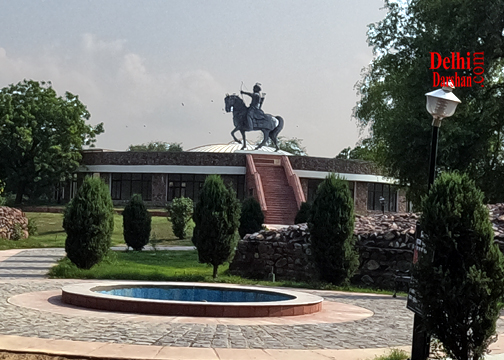Qila Rai Pithora, also known as Rai Pithora’s Fort, stands as a testament to the glorious past of Delhi, India. Located in the Mehrauli area, this ancient fortress holds immense historical and architectural significance. From its origins in the 12th century to its present-day state, Qila Rai Pithora has witnessed the rise and fall of dynasties, making it an intriguing destination for history enthusiasts and curious visitors alike.
Historical Background:
Qila Rai Pithora was constructed by Prithviraj Chauhan, the renowned Rajput king of the Chauhan dynasty, in the late 12th century. It served as the capital of his kingdom and played a pivotal role in the political landscape of that era. The fortress derived its name from Prithviraj Chauhan himself, as ‘Rai Pithora’ was his title. The architecture of Qila Rai Pithora demonstrates a unique blend of Hindu and Islamic styles, showcasing the cultural assimilation prevalent during that time.
Architecture and Layout:
Spread across a vast area, Qila Rai Pithora showcases impressive architectural elements. The fortification walls were constructed using rubble masonry, interspersed with bastions for defense. The intricate carvings and ornamental designs on the walls speak volumes about the craftsmanship of that period. The layout of the fort is divided into three main parts: the outermost enclosure known as Lal Kot, followed by the citadel area, and finally the innermost section housing the royal palace.
The Lal Kot:
Lal Kot, the outermost enclosure of Qila Rai Pithora, serves as a protective wall surrounding the fort. It was initially constructed by Anangpal Tomar, an earlier ruler of Delhi, in the 11th century. This fortified wall, made of red sandstone, stretches for several kilometers and represents the earliest surviving remnants of the fort. Although many parts of Lal Kot have weathered the test of time, it still offers a glimpse into the grandeur of the past.
The Citadel Area:
The citadel area of Qila Rai Pithora houses various structures, including the Quwwat-ul-Islam Mosque and the Qutub Minar. The Quwwat-ul-Islam Mosque, built by Qutb-ud-din Aibak, the first Sultan of Delhi, showcases splendid Islamic architecture. Its grand entrance, magnificent domes, and intricate calligraphic inscriptions are awe-inspiring. Adjacent to the mosque, the imposing Qutub Minar, a UNESCO World Heritage site, stands tall as one of the tallest brick minarets in the world.
The Royal Palace:
Within the innermost section of Qila Rai Pithora lies the remains of the royal palace, which once adorned the fort. Though time and several invasions have taken their toll, the ruins still evoke a sense of the opulence that once prevailed. The foundation walls, arches, and scattered structures provide a glimpse into the regal lifestyle of the rulers who once resided there.
Present-day Significance and Preservation:
Qila Rai Pithora, being a significant historical site, attracts both locals and tourists. The Archaeological Survey of India (ASI) plays a crucial role in preserving and maintaining the fort’s integrity. Efforts have been made to conserve and restore various structures within the complex, ensuring that future generations can appreciate its historical and architectural value.
Qila Rai Pithora or Lal Kot is a fortified complex in present-day Delhi, which includes the Qutb Minar complex. The Lal Kot is believed to be constructed in the reign of Tomar king Anangpal II. He brought the iron pillar from Saunkh location (Mathura) and got it fixed in Delhi in the year 1052 as evident from the inscriptions on it. By assuming the iron pillar as center, numerous palaces and temples were built and finally the fort Lal Kot was built around them. The construction of the Lal Kot finished in the year 1060. The circumference of the fort was more than 2 miles and the walls of the fort were 60 feet long and 30 feet thick. Anangpal II was instrumental in populating Indraprastha and giving it its present name, Delhi. Hire Delhi Darshan Agra bus, car, cab rental tour from Qila Rai Pithora for city sightseeing.
Location of Qila Rai Pithora:
Butterfly Park, Qila Rai Pithora, Sainik Farm, New Delhi, Delhi 110030 Google Map Location
Nearest Metro Station to Qila Rai Pithora:
- Saket Metro Station on Yellow Line
History of Qila Rai Pithora:
It was constructed in the reign of Tomar king Anangpal Tomar between c. 1052 – c.1060 CE. It is termed as the “First city of Delhi”. Remains of the fort walls are scattered across South Delhi, visible in present Saket, Mehrauli around Qutb complex, Sanjay Van, Kishangarh and Vasant Kunj areas. You may include this tourist attraction in your Delhi Tour Packages.
Tourist Attractions Nearby Qila Rai Pithora:
- Qutub Minar
- Jahaz Mahal
- Lotus Temple
- Butterfly Park
- Rajokri Forest
- Hauz-i-Shamsi
- Tomb of Balban
- Jain Mandir Dadabari
- Garden of Five Senses
- Jamali Kamali Mosque
- Mehrauli Archaeological Park
- Gurudwara Baba Banda Singh Bahadur
Important Information:
- “Best Time to Visit Delhi“
- “Places to Visit in Delhi“
- “Delhi Agra Bus Tour“
- “Delhi Tour Packages“
- “Delhi Bus Tour“
Other Options:
You may opt for Delhi VIP Tours or Delhi Darshan Cab Booking as well. Kindly WhatsApp us, to hire Delhi Darshan Agra Sightseeing bus, car, cab rental tour from Qila Rai Pithora.
Note:
The above-mentioned information may change from time to time. If you find any change in details, then kindly contribute with the latest information. Delhi Darshan has created this page for general information. So, that visitors to the city can get maximum output from their trip.
This post was last modified on 20 May, 2023 5:59 pm

